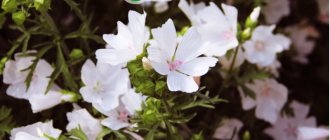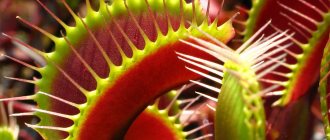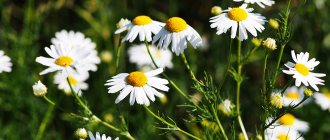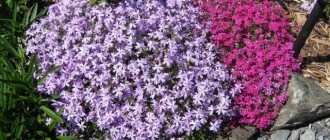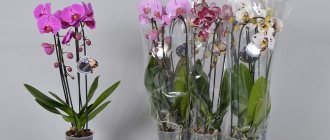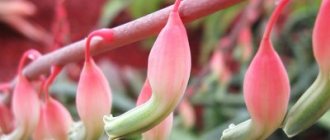Many gardeners like perennial flowers - they are easy to care for, even for beginners with minimal experience. Plants with bright yellow buds look especially beautiful in the garden - they give others a sunny mood until late autumn. Blooming lilies, chrysanthemums, daffodils and roses attract the eyes of passers-by, combined with cultures of different colors and sizes.
Yellow garden flowers perennials, photos and names of which will be given below, will help to decorate even a darkened or unsightly flower garden, add bright colors to the flower bed and front garden.
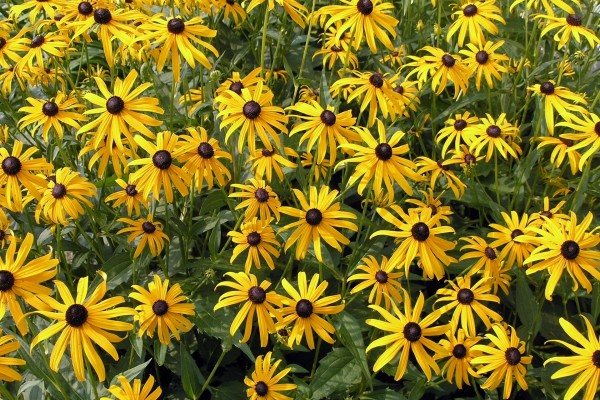
To decorate a summer cottage or a personal plot, you can use miniature, medium-sized or tall perennial flowers with a yellow color of all kinds of shades and overflows. Moreover, it is easy to choose varieties with different flowering periods, so that the sun beds look luxurious throughout the spring-summer and autumn periods.
Spring primroses
Yellow flowers that appear almost from under the snow in early spring are especially appreciated by gardeners for their beauty, brightness and early flowering. Already in April-May, these delicate primroses are able to transform a gloomy garden, decorating it with bushes with small or large buds of different shades of ocher. Below are the most popular perennials with photos and names, among the first to wake up from winter sleep, opening their petals under the rays of the warm sun.
- Crocus. This is a rather unpretentious undersized flower of the iris family, producing its small peduncles up to 10 cm high almost immediately after the snow melts and the earth in the flowerbed warms up. The period of its spring flowering is April-May, there are also varieties that bloom again in autumn, in August-September. Crocuses, in addition to yellow, are white, pink and dark blue, with a bluish tint and contrasting veins. They propagate in small bulbs, grow well on acidic fertile soil for about 4 years, gradually degenerating without transplanting. The most popular varieties with yellowish goblet buds among gardeners are Goldilocks, Golden Yellow, Yellow Mammouth.
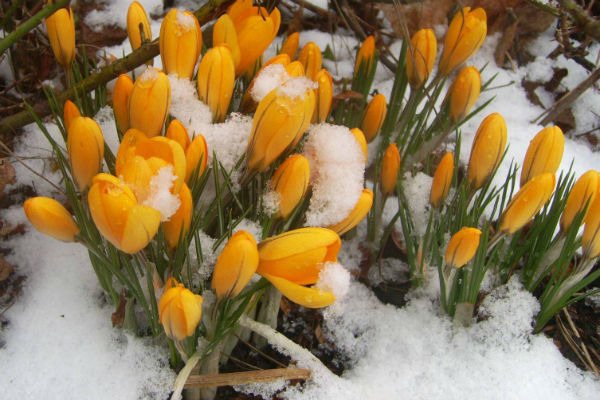

- Narcissus. This spring flower of the amaryllis family blooms at the end of April, blooms, depending on the variety, almost all of May, numbers up to 20s. Varieties with white flowers are more common in gardens, but hybrids with yellow, pink petals, different colors of cores are bred. Daffodils are perennial bulbous plants with a tart aroma, they can grow in one place without transplanting from 3 to 5-6 years, then gradually become smaller, degenerate. All species are poisonous. They love sunny, slightly shaded hills, tolerate frosts well, reproduce by bulbs and children in the spring-autumn period. They prefer nitrogen-potassium soils and need additional feeding.
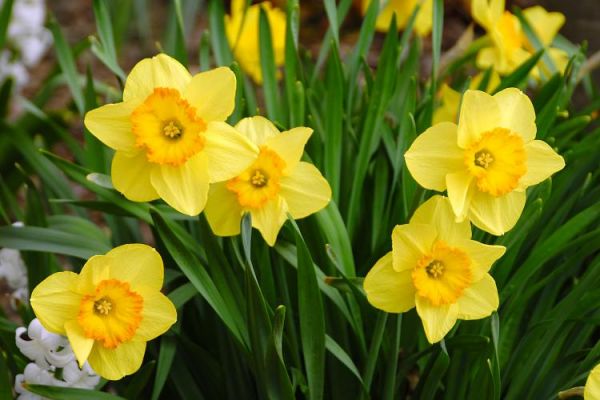

- Grouse. A herbaceous perennial plant of the lily family looks like a miniature palm with cup flowers on top. Propagated by bulbs, which are renewed every year. The stem is densely covered with lanceolate leaves, while the flowers can be yellowish-brick, yellow-lemon, burgundy, red and even purple in color. The buds are often arranged singly, but in some hybrids they are collected in umbrella-shaped panicle inflorescences. Grouse grows well on moderately moist soil, prefers illuminated areas.It does not bloom under bad weather conditions and improper planting. Such groups and subspecies as hazel grouse, gray-gray, royal, as in the photo below, Persian and two-flowered, are widely known among gardeners.
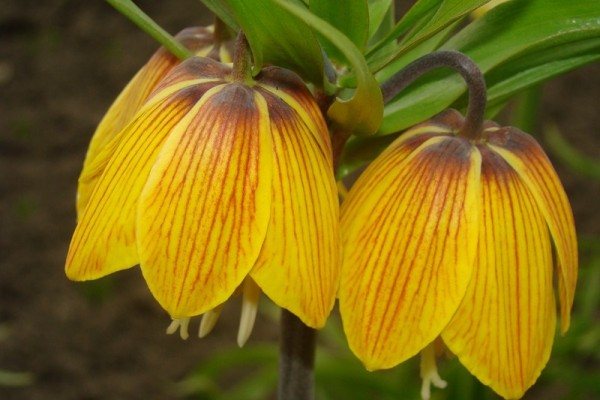

- Tulip. This spring primrose of the lily family looks great not only in gardens, but also in parks and city flower beds. Among the many bright colors (from white to pink-red, green and even black), yellow buds look solemn, very impressive. Tulips bloom in May-June, revealing goblet and ovoid turban buds on long erect stems. Flowers are propagated by bulbs planted in the ground in autumn, in September-October. They prefer slightly alkaline or neutral soil, good lighting, regular and abundant watering. They grow for 2-3 years without a transplant, then degenerate.
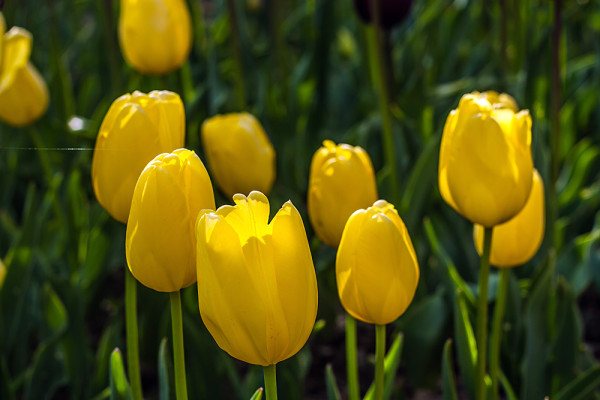

- Primrose. Herbaceous perennial belongs to the genus of primroses. Its rhizome is hidden underground, while oblong wavy green leaves and bright peduncles emerge from the outlet. Funnel-shaped flowers of various shades are collected in spherical, umbellate, tiered inflorescences, attracting attention from early spring to June. Primrose propagates by seeds and division of rhizomes, grows well in one place for more than 4 years. Compact species reach a height of 10 cm, while large ones grow up to 20 cm. The plant loves watering, feeding, loose soil, tolerates wintering well.
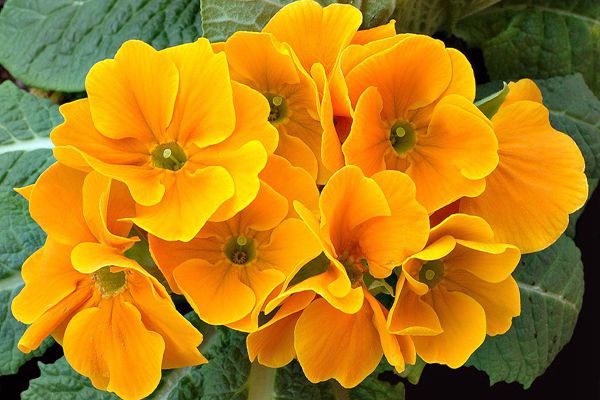

- Iris. Perennial of the genus rhizome, iris family. It has a filamentous rhizome, flat long xiphoid leaves, collected in a bunch. Irises bloom from May to June, wither quickly, in about 5-6 days. The flowers are single, large, fragrant, usually blue-violet or yellow, but there are varieties with unusual colors. There are 6 petals in the bud, the lower ones are slightly turned outward, while the upper ones resemble a tube. Marsh (pseudo-aira) irises and Lemon Touch spuria are yellow in color. The flower grows well in one place from 5 to 10 years, loves sunny places without drafts and nutritious soil.


Flower golden balloon care
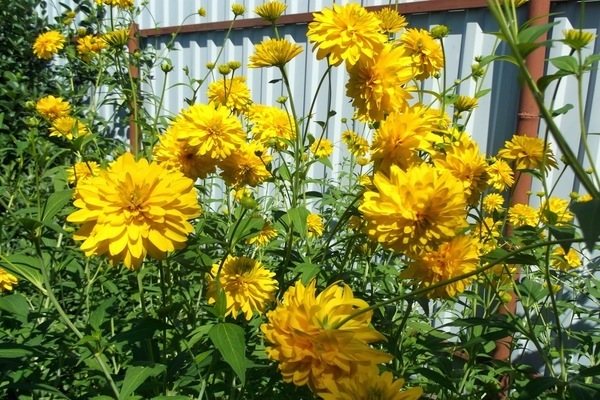

In this article, we will consider the conditions for caring for rudbeckia in the open field. These flowers are considered to be quite drought tolerant. However, the rudbeckia will feel better if the watering is more abundant in hot weather. If this is not done, the flowers may lose their beauty.
After the rudbeckia has faded, cut off the part of the plant that is above the ground. About 10 cm should remain from the stem. In open areas, rudbeckia grows very quickly and can interfere with neighboring plants. This is important to consider when planting plants. You can choose a separate place for the rudbeckia or make a partition for the roots.
Every 5 years the flower needs to be thinned out, you can remove whatever you want. It is not necessary to cover the flower in winter. Fertilize rudbeckia in May and late summer. The first feeding is done before flowering, the second can be done in the first days of autumn. Any mineral complex is suitable for feeding this plant. Without feeding, the plants will be less lush and the flowers will be less vivid in color.
Pests of rudbeckia are not terrible, like diseases. It is quite resistant to both the first and the second. If you run the plant hard, then powdery mildew can appear on it. This disease manifests itself as a white bloom on the plant. If you still allowed this, then you will need to spray the plants with liquid copper sulfate or colloidal sulfur.
If you notice brown spots on rudbeckia, it means that there is a leaf nematode. If your plant is sick with this disease, it is worth spraying it with Basamid or Nemaphos.
Large-flowered and tall perennials
Yellow garden flowers with large buds are visible from afar, especially if planted together, not singly.They can grow for a long time along fences, next to ornamental shrubs or in flower beds, creating a sunny mood in the garden with their bright colors. Most often, site owners plant such plants in plain sight, substituting supports or arches for curly, bush varieties, tying up spreading stems. The following perennial crops are most popular with florists.
- Lily. A luxurious flower of the lily family is able to decorate any corner of the garden. More than 80 types of bulbous perennial lilies are known. Among them, varieties with lemon-yellow and yellowish-orange flowers stand out for their bright color, large petals. The most popular names among gardeners are such names as Blazing Dwarf, Aelita, Adeline, Edvantage, Yellow Cocot, Big Brother. A capricious, but very beautiful flower propagates by bulbs, has many leaves on a long, erect stem. Different hybrids grow up to 50-230 cm, have up to 15-16 large flowers at the same time. Lily loves fertile soil, rare watering, tolerates winter frosts well with proper care.
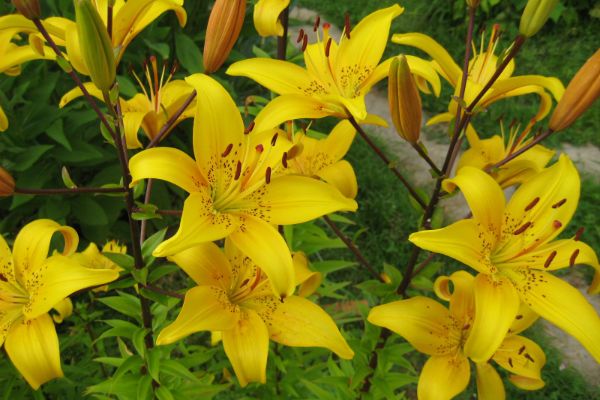

- Pion. Herbaceous, shrubby and tree-like perennials are popular for their beautiful flowering, delicate aroma and lush bud caps. They bloom in May-June, do not shed their petals for 4-5 weeks. The height of the bushes often reaches 80-100 cm. The rhizome consists of cone-shaped roots, from which several shoots grow. The pinnate leaves have a gray-green or red-violet color, while the color of flowering caps up to 20 cm in diameter is more varied - white, pink, red, yellow. The peony has been growing in one place for more than 10 years, loves feeding. Propagated by dividing the bush during transplantation.
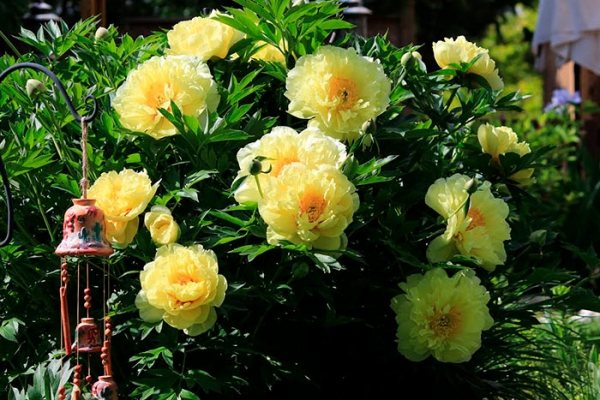

- Rose flower. Shrub, park and climbing varieties are distinguished by a strong floral aroma, abundant flowering several times per season, a spectacular look of foliage and blossoming buds. Numerous varieties with yellow flowers look festive and give a sunny mood. Popular names for hybrids are Geisha, Pilgrim, Decor Harlequin, Arthur Bell, Golden Wedding, Golden Celebration and others. However, growing a rose is difficult. This bushy perennial is quite capricious, prefers frequent watering, fertile soil with top dressing, requires protection from diseases and pests.
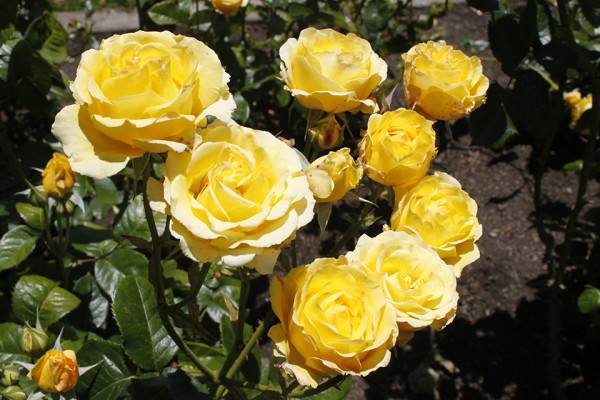

- Chrysanthemum. This perennial garden plant belongs to the Asteraceae or Asteraceae family. More than 1000 varieties of an unusually beautiful flower, popularly called golden, have been bred. Herbaceous or bush subspecies grow up to 20-70 cm, depending on the variety, have small or large flowers that adorn the garden from July to October. In miniature species, inflorescences-baskets reach 1-2 cm, in large ones, the caps open up to 20 cm in diameter. Inflorescences are pompom, simple, semi-double and double, anemic, bristle (see photo). Chrysanthemums grow well and bloom luxuriantly in sunny, ventilated areas, multiply by seeds, cuttings and division of the rhizome during transplantation.
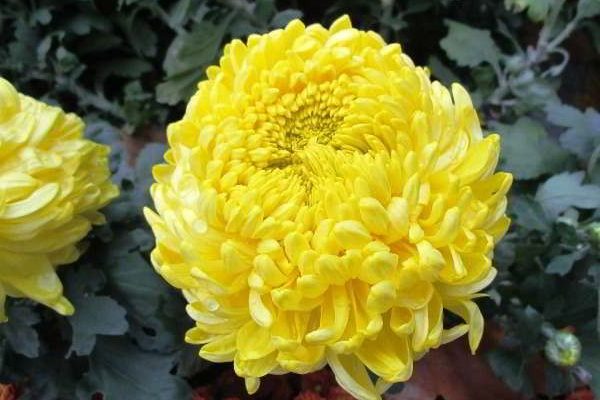

- Rudbeckia. The herbaceous perennial plant is a member of the Aster family. There are about 40 species in the genus. The flower has branched or simple stiff-pubescent shoots that grow up to 2 meters and more. The leaves are pinnately divided or dissected, oval in shape, up to 20 cm long. Baskets-inflorescences reach 15 cm in diameter, consist of sterile marginal reed flowers (see photo). Their color includes all shades of yellow, while the middle can be black-purple, brown or yellowish. Most often, gardeners grow such varieties of perennial rudbeckia as shiny or radiant, dissected, western, glossy, beautiful, giant. In leaving, the flower is picky, responsive to watering and feeding.
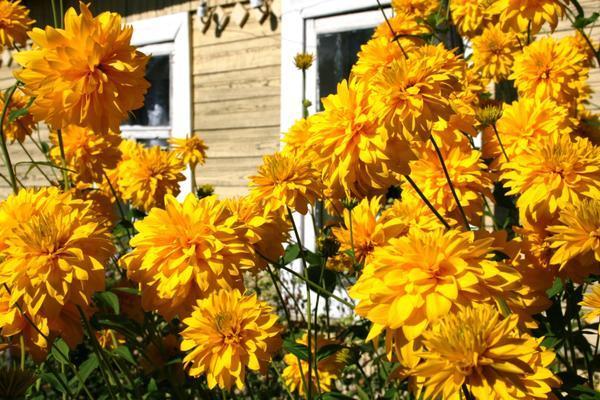

Yellow flowers
Florists prefer to choose perennial plants for growing. Perennials are convenient because they significantly save time and energy, they do not need to be planted and grown from seeds every year. Depending on the place of residence (private property or apartment), flora lovers perennials are divided into two categories:
- room;
- garden.
There is also an unspoken, third category: field flowers, "Domesticated" by enterprising flower growers. Experienced gardeners try to plant their favorite field plants on their backyard plots.
Low-growing plants with small buds
Low-growing perennials with yellow inflorescences and buds look great in flower beds, small beds, grow on alpine hills and along paths, fences. These bright plants effectively set off tall varieties with red, blue, orange flowers, emphasize the beauty of green spaces, hedges. The most common names in gardens and front gardens are the following perennial species.
- Viola. The flower belongs to the violet family, is popularly called pansies. More than 100 varieties of the plant are known. Flowering lasts from spring to late autumn. Bushes with an erect main shoot grow up to 15-30 cm tall, have pinnately dissected leaves. The root system is fibrous, the leaves of the viola are collected in a basal rosette or grow alternately. Flowers are axillary, single, up to 7 cm in diameter, open on long peduncles. Viola's colors are monochromatic, tricolor, spotted, and the petals are simple or double. The plant propagates by seeds, loves bright sunlight and moist soil.
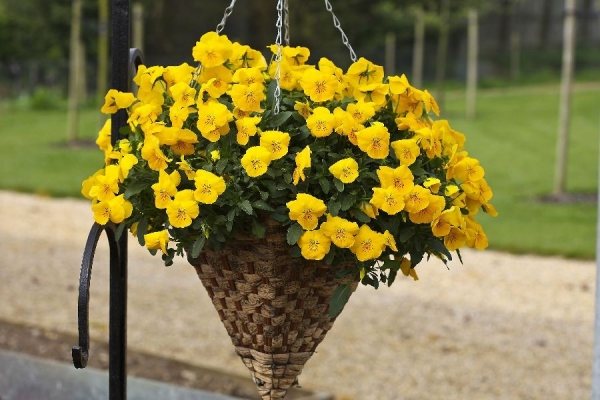

- Swimsuit. Herbaceous perennial plant belongs to the buttercup family. There are about 20 known species of this flower, which prefer to grow in moist soil. The leaves of the swimsuit are palmate or lobed, the formation of peduncles occurs over the course of two years. In the first year, a root rosette is formed, in the second year, an shoot grows with a flower at the top. The blossoming buds have a different color - from greenish to yellow-orange. The smell attracts bees, the fruit is a leaflet, the seeds are colored black. The bather loves to grow in both shaded and sunny places, loves open areas and regular watering.
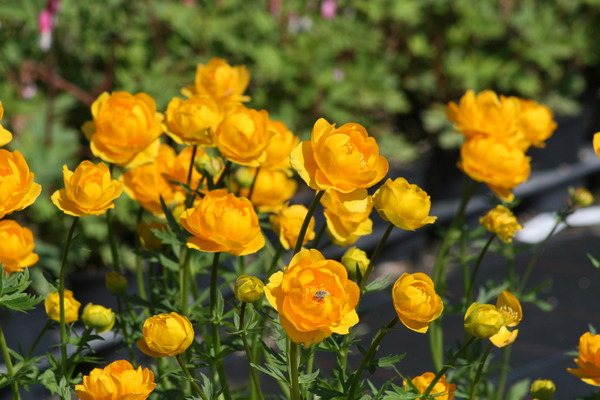

- Adonis. A perennial plant of the buttercup family up to 50 cm in height has a branched stem, many narrow leaves with finger lobes. During flowering, its lush, but low bushes are covered with red or bright yellow single flowers, similar to field daisies (see photo). The diameter of flowers with glossy petals rarely reaches 6-7 cm. Adonis prefers to grow in sunny places, loves fertile soils, high humidity. Poorly tolerates transplants, propagates by seeds.
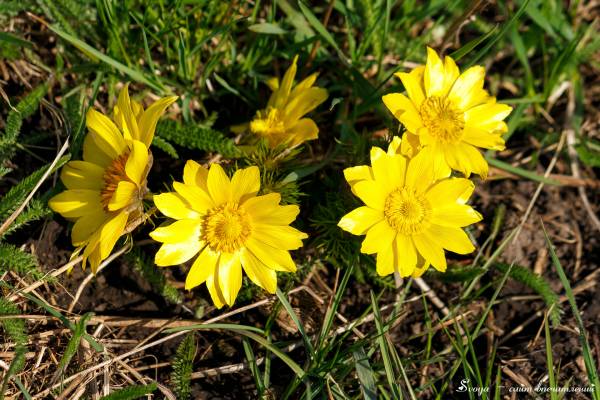

- Ranunculus. The second name of the flower of the buttercup family is the garden buttercup. There are about 600 different species known in the plant, which looks like a peony or a rose with its lush small bud. The height of the ranunculus does not exceed 30-70 cm, the rhizomes are represented by tubers. Deeply dissected leaves are attached to strong shoots, flowers are semi-double, double and densely double. Their diameter is about 5-8 cm, the colors vary from white-pink to red, yellow, mixed. The plant sap is poisonous. Likes to grow in partial shade on swampy soil, does not tolerate drafts and loamy soil. Propagated by seeds.
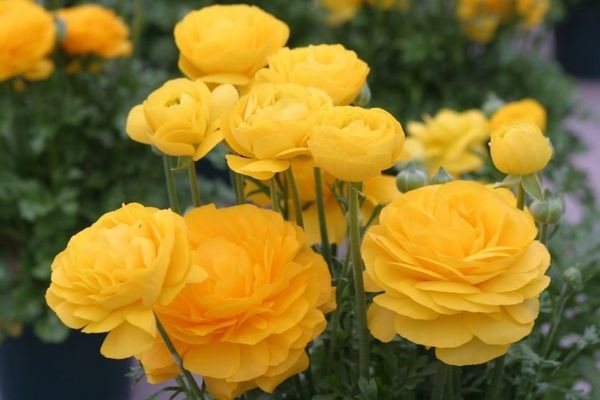

- Sedum (sedum). The perennial flowering succulent belongs to the jumbo family. The creeping ground cover shrub has spread stems, grows up to 15-30 cm. Fleshy petiolate oval leaves grow on the shoots. They can be bloated or flat. The color depends on the variety, most often the leaves have a grayish, pinkish or greenish tint. Shoots root easily, forming a thick carpet in rockeries or in the middle of an alpine hill.Sedum with yellow flowers, collected in umbellate inflorescences, cover the ground like small stars. The most common sedum in gardens is large (or ordinary) sedum and Kamchatka sedum. It is better to plant the plant with seeds, choosing a well-lit place in an area with fertile soil.
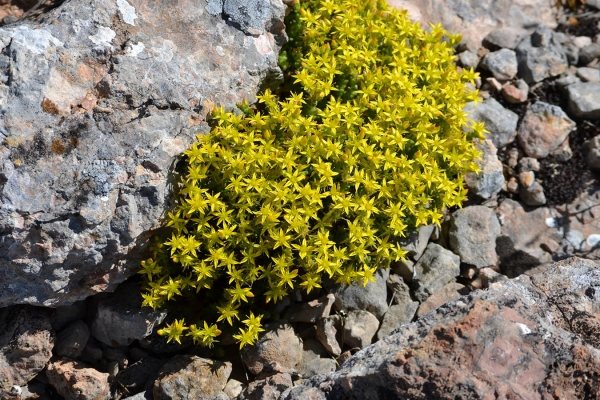

You can study perennial plants with yellow flowers in more detail by watching a video on this topic.
Begonia
This interesting plant can have a variety of colors and shades. Most often, the leaves are terry, which makes the plant even more original. Moreover, this is not only a garden, but also an indoor flower with yellow flowers. The plant itself is unpretentious. Moreover, there are many varieties. At the same time, the colors can be different - from lemon to carrot.
All care for this plant is timely watering. It is also better not to leave it in the sun itself. Periodically, you can carry out top dressing, but not with fresh manure, it is better to take humus in small quantities.
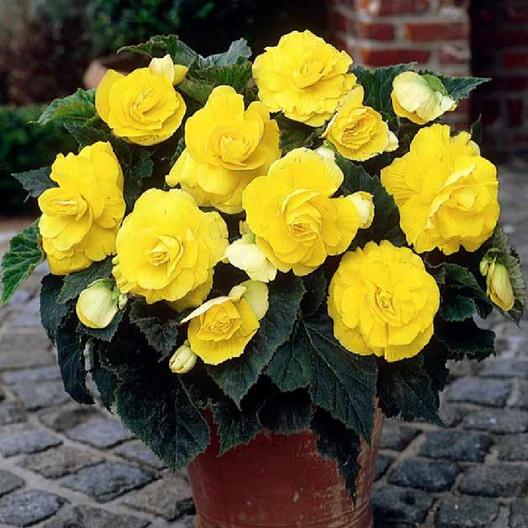

Flowering plants can decorate any site. And if they are also bright in color, then rest in the country will turn into a real pleasure for the eyes. Sunny color, yellow, exists in many popular colors. So, peonies, lilies and crocuses have long been able to delight the eye with just such shades.
Do not believe evil omens: to whom and for what reason you can give yellow flowers
What does the yellow color of specific plants mean and who can you give them to?
Yellow roses
Roses of the color of the sun symbolize friendly disposition, happiness. If you give such a bouquet to your chosen one, it means that you admire her, demonstrate a desire to take care of her. And also a rose is an emblem of mature love and a prosperous family life.
- Friends and relatives for their birthday.
- Married couple on their wedding anniversary.
- Artists and people of creative professions.
Yellow roses presented to a beloved woman are a good way to ask for forgiveness after a falling out, to offer to start everything from scratch.
Such a bouquet of 51 roses will cause only positive emotions.
Sunny tulips
Sunny tulips, despite prejudice, are positive flowers, meaning the happiness that "hides" inside the bud. They are given by lovers, hinting at tender feelings or just to cheer up, wish good luck, congratulate on a significant date.
- Girl on the first date.
- Mom, sister, grandmother, colleague, friend, teacher on March 8.
To show friendship, respect, add blue irises to the tulips
Chrysanthemums fall color
In the East, chrysanthemums symbolize power, wealth, longevity, health. Single-headed chrysanthemums of golden color, presented to a girl or a second half, mean quivering love, a desire to always be there.
- To the boss, business partner, colleague.
- Teacher, teacher.
- Beloved woman.
Such chrysanthemums look great in mono-bouquets and prefabricated compositions.
Gerbera gold
Yellow gerberas are a flower of happiness. A large "chamomile" outwardly resembles the sun, with all its appearance radiates warmth, light, kindness. This is a universal gift for any occasion and to any person for whom you have friendly feelings.
A summer bouquet that radiates positive
Yellow calla lilies
Callas are the standard of grace and majestic beauty. The flower, simple in shape, is full of charm and at the same time looks solemn. He is considered a talisman of family happiness, and yellow calla lilies also personify wealth and success.
- Beloved woman with a proposal for marriage.
- Spouse.
- Anniversary (she).
Flowers for beloved
As you already understood, yellow flowers do not carry any threat. They can and should be given to everyone who likes bright sunny bouquets. But if you are afraid that your girlfriend will misinterpret the present, accompany the gift with warm words of recognition.
Yellow lilies
Lilies are among those plants that enjoy special respect in the culture and art of many nations. Beautiful graceful flowers adorn monograms and coats of arms of noble houses in many European countries. In floriculture, among lilies of yellow shades, the most widespread are:
- Blazing Dwarf is an Asian dwarf yellow lily with large fiery orange flowers. The early variety is famous for its abundance of flowering.
- Aelita is a lily from the group of Asian hybrids. It has loose inflorescences, collected from 10-15 star-shaped flowers of the original two-tone color with the inclusion of yellow and brown shades.
- Big Brother is a tall variety with large flowers reaching a diameter of 25-30 cm. The early variety is interesting for the contrasting combination of vanilla-yellow petals with black stamens. During the flowering period, it has a pronounced aroma.
- Yellow Cocotte is an Asian hybrid with medium-sized double flowers of a rich yellow hue. The variety is attractive in that it has underdeveloped anthers, due to which it does not cause allergic manifestations.
Separately, it is worth highlighting a plant called the yellow water lily. It is often called a water lily or a yellow water lily. Herbaceous perennial in nature grows in small lakes, rivers, where weak currents prevail. In landscape design, the diving beetle can be successfully used in the design of decorative ponds.
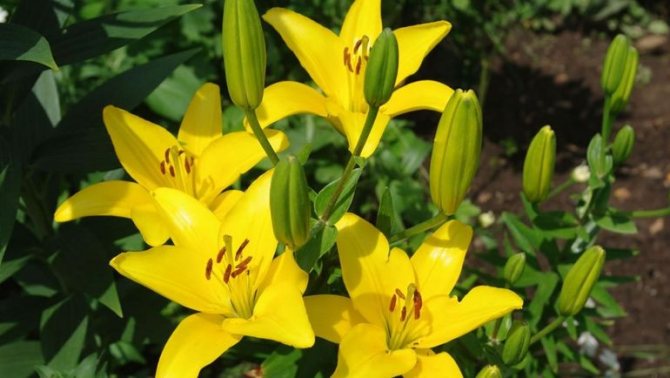

Yellow cocotte



